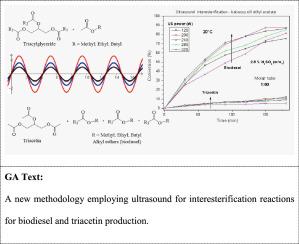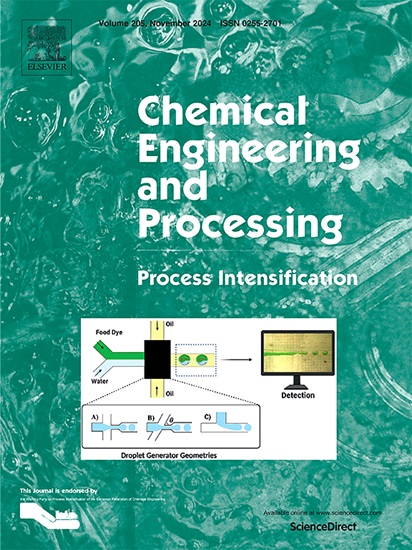Ultrasound assisted interesterification of babassu oil with acetates using acid catalysts for biodiesel and triacetin production
IF 3.8
3区 工程技术
Q3 ENERGY & FUELS
Chemical Engineering and Processing - Process Intensification
Pub Date : 2024-10-15
DOI:10.1016/j.cep.2024.110028
引用次数: 0
Abstract
The ultrasound-assisted (US) interesterification of babassu oil with methyl, ethyl and butyl acetates was carried out via acid catalysis for biodiesel production with triacetin as an additive and therefore filling the gap in the field of US induced interesterification reactions. The scanning for the best catalyst was performed using sulfuric, methanesulfonic, p-toluenesulfonic, phosphoric and acetic acids. In order to achieve optimal conditions reactions varied in terms of reactant molar ratio, type and concentration of catalyst, temperature (20 to 50 °C) and ultrasonic energy (120 to 320 W). Using ethyl acetate, reactions were carried out at various molar ratios of oil to acetate (1:12 to 1:72) using sulfuric acid (0.5 % w/wT). The 1:60 experiments were carried out with sulfuric acid concentrations ranging from 0.5 % to 3 % (w/wT). The best catalytic activity was sought using the acids at a concentration of 2.5 %, with 200 W and 1:60. The best catalytic activities were achieved with H2SO4 followed by CH3SO3H and CH3C6H4SO3H and the reactivity follows the ethyl→methyl→butyl trend. The best results were achieved using ethyl acetate with H2SO4 yielding 95.4 % biodiesel plus triacetin with a content of 17.6 % of triacetin in 180 min, which represents an intensification of 25.4 % compared to conventional heating.

使用酸催化剂超声辅助巴巴苏油与醋酸盐的酯化反应,以生产生物柴油和三醋精
该研究通过酸催化技术将巴巴苏油与醋酸甲酯、醋酸乙酯和醋酸丁酯进行超声波辅助(US)酯化反应,以三醋精作为添加剂生产生物柴油,从而填补了 US 诱导酯化反应领域的空白。使用硫酸、甲磺酸、对甲苯磺酸、磷酸和乙酸对最佳催化剂进行了扫描。为了达到最佳条件,反应在反应物摩尔比、催化剂类型和浓度、温度(20 至 50 °C)和超声波能量(120 至 320 W)等方面都有所变化。使用硫酸(0.5% w/wT),以不同的油与醋酸乙酯摩尔比(1:12 至 1:72)进行反应。1:60 实验使用的硫酸浓度为 0.5 % 至 3 %(重量比)。使用浓度为 2.5 %、功率为 200 W 和 1:60 的硫酸时,催化活性最佳。H2SO4 的催化活性最好,其次是 CH3SO3H 和 CH3C6H4SO3H,反应性遵循乙基→甲基→丁基的趋势。使用乙酸乙酯与 H2SO4 的效果最好,在 180 分钟内可生成 95.4% 的生物柴油和三醋精,其中三醋精的含量为 17.6%,与传统加热相比提高了 25.4%。
本文章由计算机程序翻译,如有差异,请以英文原文为准。
求助全文
约1分钟内获得全文
求助全文
来源期刊
CiteScore
7.80
自引率
9.30%
发文量
408
审稿时长
49 days
期刊介绍:
Chemical Engineering and Processing: Process Intensification is intended for practicing researchers in industry and academia, working in the field of Process Engineering and related to the subject of Process Intensification.Articles published in the Journal demonstrate how novel discoveries, developments and theories in the field of Process Engineering and in particular Process Intensification may be used for analysis and design of innovative equipment and processing methods with substantially improved sustainability, efficiency and environmental performance.

 求助内容:
求助内容: 应助结果提醒方式:
应助结果提醒方式:


